Review By: Mr. Roboto
Authors: Dan O’Bannon & Jean “Moebius” Giraud (Illustrator)
Year: First appeared in Metal Hurlant, 1976
Category: Cyberpunk Books; Graphic Novels; Proto-Cyberpunk Media
Another piece of the proto-cyberpunk puzzle is found. So far, proto-cyberpunk media has dealt more with the themes of cyberpunk. But what about the look, that Blade Runner-esque future with stratosphere busting skyscrapers and flying cars? Did Ridley Scott have that vision in his head all along?
NOPE.
As it turns out, there was a major influence that would spark the future visions of Scott and Gibson: A short comic about a private eye (or “nose” as the main character called himself) who is hired to retrieve a package. The story itself isn’t much (too short to call it a novel), but the artwork is what influenced Scott and Gibson.
(From Blade Runner Movie site) “Years later, I was having lunch with Ridley, and when the conversation turned to inspiration, we were both very clear about our debt to the Metal Hurlant [the original Heavy Metal magazine] school of the ’70s–Moebius and the others. “
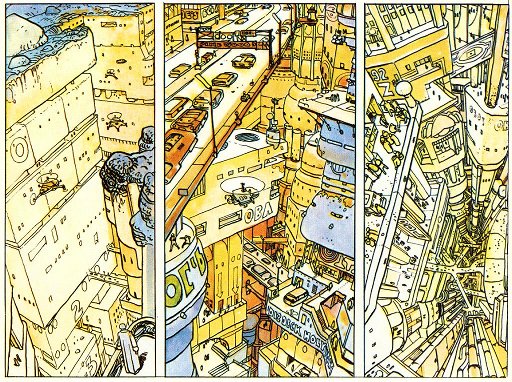
Problem: Metropolis had these city scenes some fifty years earlier! Did Gibson and Scott ever see Metropolis? Apparently not, since they give their props to Moebius:
“So it’s entirely fair to say, and I’ve said it before, that the way Neuromancer-the-novel “looks” was influenced in large part by some of the artwork I saw in ‘Heavy Metal’. I assume that this must also be true of John Carpenter’s ‘Escape from New York’, Ridley Scott’s ‘Blade Runner’”, and all other artefacts of the style sometimes dubbed ‘cyberpunk’. Those French guys, they got their end in early.”
Fritz Lang and the Germans beg to differ.
My advice: Check both out and see who had the future first.
This post has been filed under Proto-Cyberpunk Media, Cyberpunk Books, Graphic Novels by Mr. Roboto.
Review By: Mr. Roboto
Authors: Robert Venditti & Brett Weldele (illustrator)
Year: 2006, 2009
Category: Cyberpunk Books; Graphic Novels
NOTE: This review will cover both graphic novels The Surrogates and The Surrogates: Flesh and Bone.
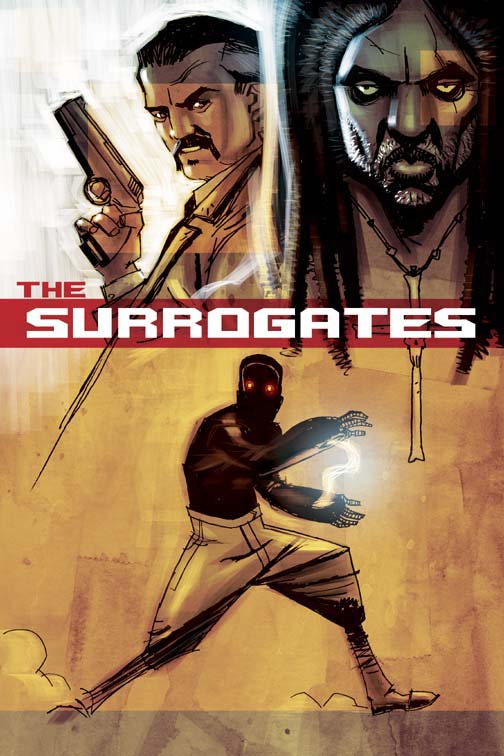
“Live”
Coming to a big screen near you. With the Surrogates movies opening this Friday (Sept. 25), I’d thought we should check out the book that it is based on. Originally a five issue comic, The Surrogates shows life in 2054 Georgia (US) as a police detective searches for a person who is destroying “surrogates,” robotic avatars that people use to interact with the real world from the safety of their homes. There is also a prequel, The Surrogates: Flesh and Bone. The two books are combined into the The Surrogates: Owner’s Manual.
Synopsis: Lieutenant Harvey Greer investigates the destruction of two surrogates that is first attributed to a “flash storm.” A data-recording unit on one of them shows that they were actually destroyed by an electrical discharge from someone or something that would be called the “steeplejack.” Greer suspects that the steeplejack may be working for a religious cult called The Church of The Prophet, aka the “Dreads,” who are known to have a history against surrogates.
As Greer delves deeper into the mystery, his own surrogate is destroyed by the steeplejack, who plans to disable or destroy all the surrogates. Instead of replacing it, he decides to continue without it, and does find who is behind the steeplejack and the anti-surrogate plot.
In the prequel, Flesh and Bone, a homeless black boy is beaten and killed by rich white kids using their parent’s surrogates. This causes the Dreads’ anti-surrogate movement to swell, leading to a riot when the most reliable witness to the beatings is killed before them. After some negotiations, the Dreads are allowed to leave the city and setup a “nation” where they can govern themselves. In this book, Greer is a patrolman waiting to hear back about his detective test.
Back Stories. In between the chapters of ink-on-single color pages come some ephemera that sets a bit of background: A research paper on the benefits of surrogates, a questionnaire, news clippings, and even “pamphlets” from Virtual Self, Inc. (Life… Only Better) and The Church of The Prophet (The Dreads). These add to the story by filling in some back details about how and why the surrogates became so popular and despised. In particular, a news transcript about Zaire Powell III proves quite revealing on how he murdered his baby sister and then set fire to his home killing everyone else. After his release he founded the Dreads movement.
But is it cyberpunk? If you need to ask, you must not be paying attention. I can say with confidence that *YES*, The Surrogates series IS cyberpunk. If the beating at the beginning of Flesh and Bone didn’t beat that point home, consider this: Greer’s wife commits suicide when her surrogate is disabled.
But, there are still some questions left; Will the movie follow the novel(s)? Probably not exactly, but Blade Runner didn’t follow Phillip K. Dick’s novel exactly either. Will the movie be any good? I’ll let you know this weekend…
This post has been filed under Cyberpunk Books, Graphic Novels by Mr. Roboto.
Art Book Review By: Ak!mbo
Author: Otomo Katsuhiro
Year: 2007
Degree of Cyberpunk Visuals: Very high.
Correlation to Cyberpunk Themes: Very high.
Category: Cyberpunk Art Books
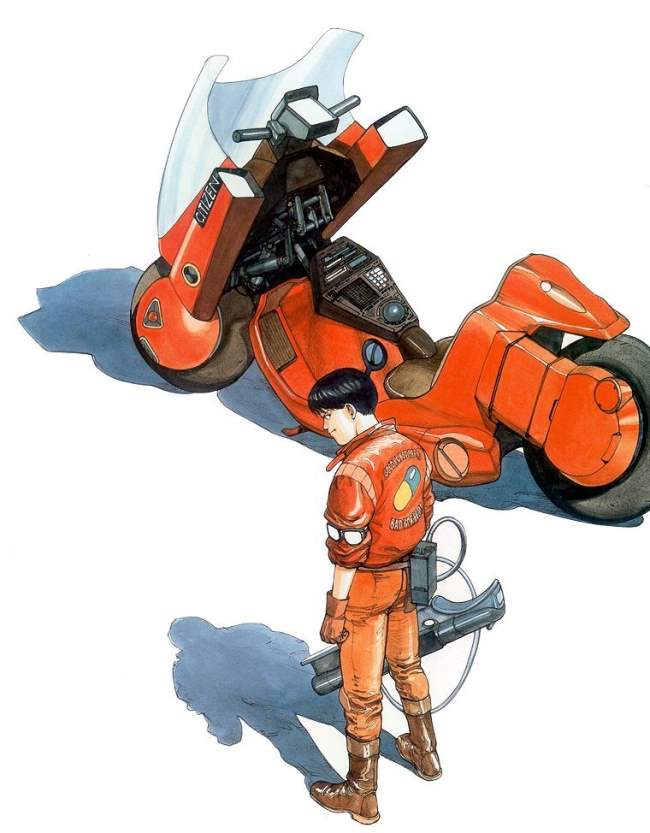
Overview: Akira Club is an art book featuring cover art, sketches and outtakes from the paperback Akira collections. It’s a little pricey at thirty bucks when most the artwork is in black and white, and another set back is the format, which doesn’t match the Akira books. Though mostly presented in black and white, Otomo Katsuhiro’s artwork will blow your socks off. The artwork in Akira Club is incredibly detailed and the author’s commentaries and sketches really show you how much work has been put into the product. While penned many years ago, it doesn’t look a bit outdated. Akira is an epic piece of work at over 2000 pages and has won awards and prestige around the world. The animated movie based on the manga re-introduced the west to Japanese animation in the nineties. The quality of animation mirrors that of the manga and although large parts of the manga were cut from the movie, it still gets the story through to the viewer pretty well.
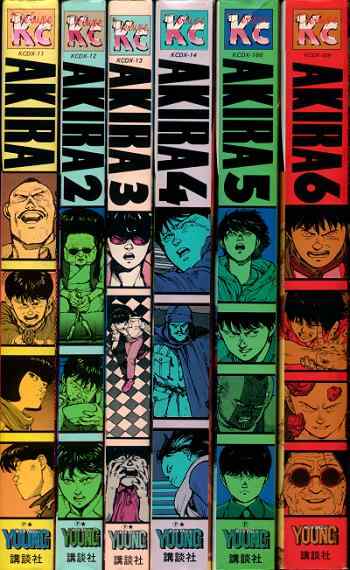
Background: The world of Akira is set after world war three and the destruction and rebuilding of Tokyo. Themes include transhumanism, corruption, low life and high tech and Akira comes across as incredibly cyberpunk, mostly focusing on the life of those on the ground in a super industrialized and militaristic Neo Tokyo. The artwork in Akira Club pretty much represents these themes in great detail. There’s a contrast between the giant, symmetrical skyscrapers which dominate the Neo Tokyo skyline and the life on the ground where there are a lot of organic and seemingly random shapes. There’s also a recurring theme of order put in chaos, like the front cover image; smooth motorcycle parts are jumbled together in a giant mess creating disarray where there once was a finely tuned machine, everything put together neatly.
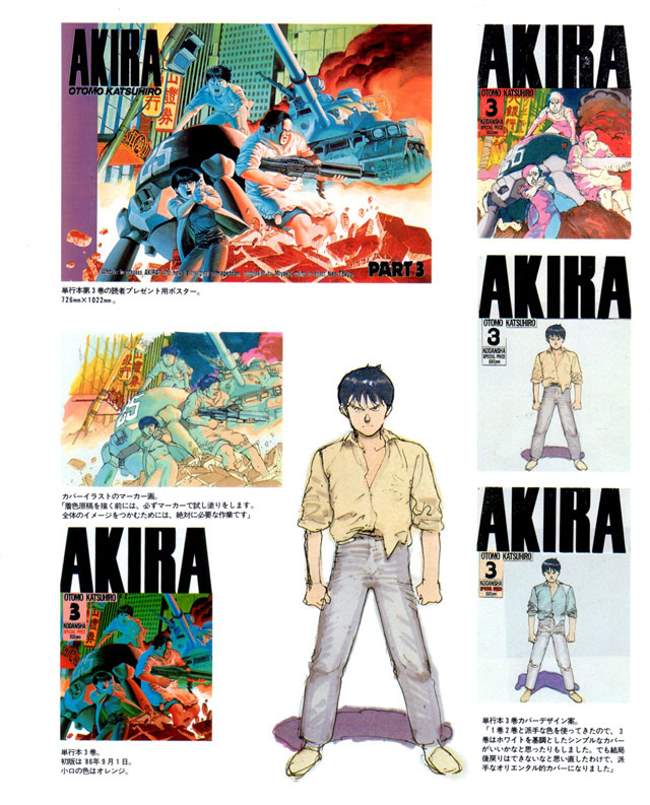
A lot of the magazine covers show a destroyed Neo Tokyo behind mostly young people. The city being destroyed by a secret weapon created by the government, this gives a pretty strong image of the world being handed over to future generations ruined by our predecessors’ lust for more power through technological advances.
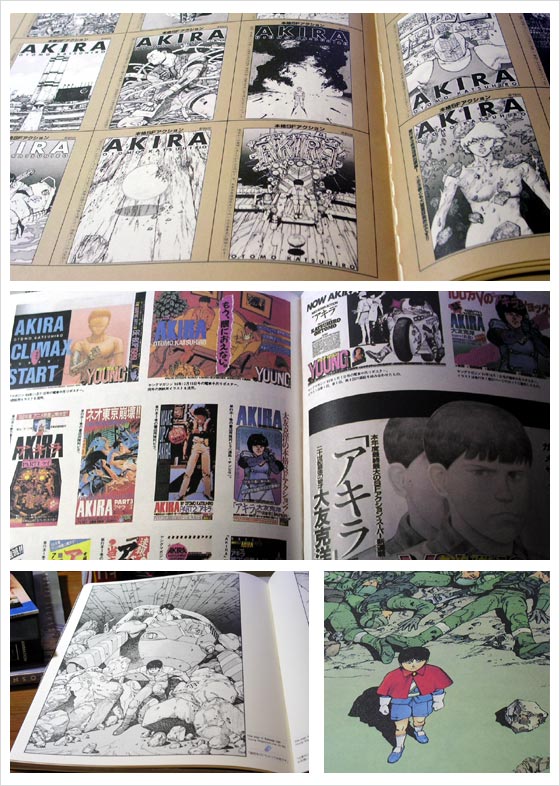
The Sections: The book is divided into four sections:
- Section One: The first section collects several full colour paintings of magazine and book covers, T shirt designs and promotional posters, supplemented with preliminary sketches and short comments from the author; Otomo Katsuhiro.
- Section Two: The second section is the biggest and focuses on the covers used for each chapter when Akira was serialized in Young Magazine. These weren’t included in the paperback collections because they’d break up the natural flow of the story, so having them collected here is kinda nice as the artwork is generally stunning. These do not include comments on the artwork but little musings on life by the author, which I personally found incredibly uninteresting.
- Section Three: The third section collects all sorts of odd artwork used in advertising and merchandise, there’s a lot of great art, but all in all it’s not as interesting as the last section of the book. Also included here are notes on the translation of Akira.
- Section Four: The fourth section is probably the coolest out of the whole book, although I wish it were longer. Titled, “Unpublished Works,” it shows panels and scenes that were never included in the finalized Akira comic books, some pages include parts that were included in the serialized version of the comic, but were cut from the paperback collections.
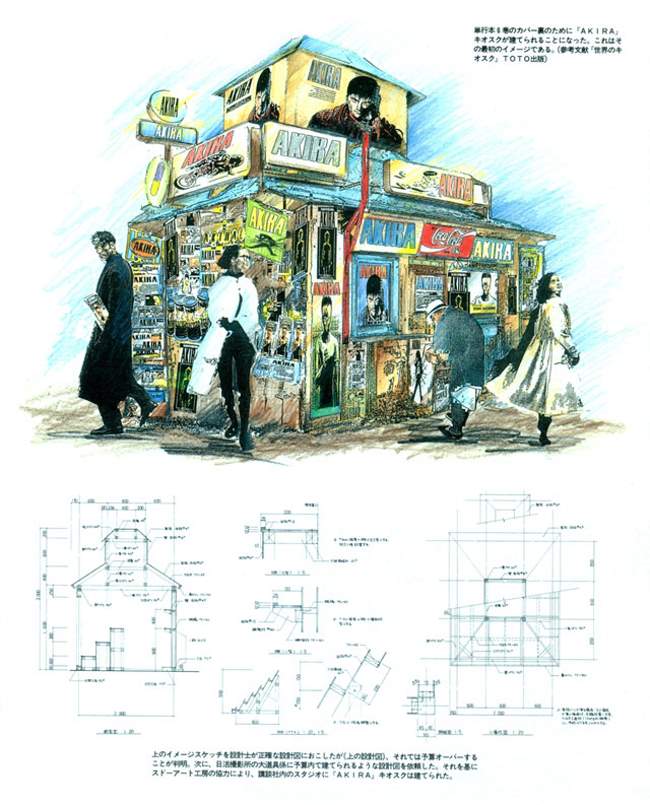
The Bottom Line: Having “read” through the book, I feel a little let down; it’s like there’s something missing. The artwork, though awe-inspiring, is as noted mostly in black and white, and I feel there could have been more colour illustrations put in to compensate for the large number of cover illustrations from Young Magazine. The last part of the book could also have been a little longer. At two thousand pages, I’m sure there is more unpublished material than on display here. I’d like to see the parts excluded from the paperback collections in better detail, preferably in entirety, as I’m sure others are as well. I’ve only had access to the translated collections and would like to know what I’ve been missing out on.
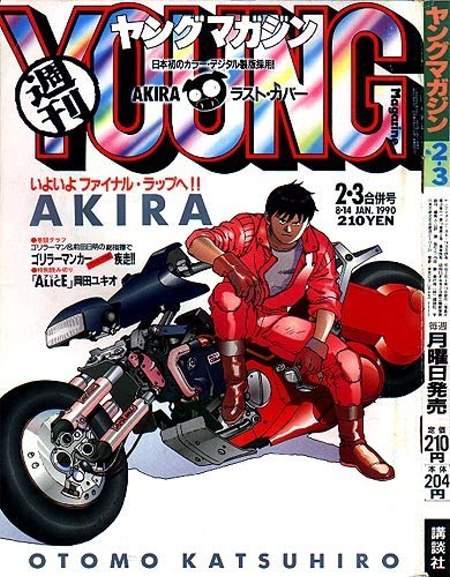
Should You Buy It? All in all, Akira Club is really for those with specialized interests, such as rabid Akira fans, anime historians and artists looking for inspiration in cyberpunk drawings of landscapes and dystopic scenarios. And even for these select few, the book isn’t perfect. However, I think of it as a nice addition to my bookshelf and I browse through it regularly, still “Ooh’ing” and “Aah’ing” at the incredible art. I wouldn’t say this is a must for cyberpunk or indeed Akira fans, but if you think you can afford it, it’s a good purchase and a great gift for those already familiar with the universe and story, be that through the manga or the anime version of Akira.
This post has been filed under Cyberpunk Books, Graphic Novels by Mr. Roboto.

Ghost in the Shell: Stand Alone Complex (GITS SAC) is about to be released as a novel. Dark Horse Comics has the publish date slated for two days from now (May 24th). Originally, this was supposed to be released a month or two ago. Dark Horse’s description for GITS SAC is as follows:
In the not-too-distant future of 2032, the frontier dividing humans and machines has been crossed. Crimes comitted by flesh-and-metal cyborgs are investigated by Section 9, an elite counter-terrorist squad run by Chief Aramaki and his cyborg assistant, Major Motoko Kusanagi. Section 9 has faced countless adversaries in the real world and in cyberspace, but none like ‘The Awakened.’It is believed that this lethal group of terrorists can take over the minds and bodies of almost anyone. Used as tools to commit crimes against the state, the victims are unaware of who or what is controlling them. When Major Kusanagi captures one of the victims, she hacks into his cyberbrain to learn the ringleader’s identity-what she discovers leads her on a journey deep into the heart of cyberspace, a journey that shakes her to the core.
I’m not quite sure whether the novel will be exploring a Laughing Man variant type story from Season One, or whether this is something completely different. The “Awakened” thing doesn’t ring a bell for me though, so perhaps this is completely different. Also, I’m not sure if the cover above will be used or the more explicit cover floating around. In any event, I’m definitely looking forward to this.
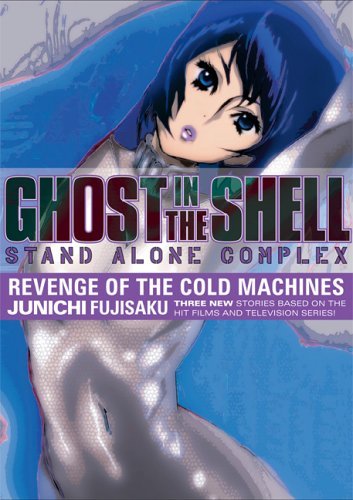
The second volume is currently scheduled to be published on July 19th. Dark Horse’s description for Volume 2 is as follows:
2030 Tokyo: While patrolling Tokyo’s post-World War Three refugee zones Togusa, the newest member of Section 9, discovers that one of the most powerful cyber-criminals his squad has ever faced has plans to kill their leader, Section 9 Chief Daisuke Aramaki, in one of three stories in this collection, and it will take all of the members of Section 9 to stop him. The action heats up in the stories “Double Targets,” “First Love, Last Love,” and “Revenge of the Cold Machines.”
I don’t know whether there will be any artwork in these or not though - I kind of hope so as I love Masume Shirow’s work. I originally had a second paragraph above in the first volume description that seemed to indicate this as such, but in looking at it, it appeared to refer to previous GITS TPBs.
This post has been filed under Graphic Novels by SFAM.
Author: Warren Ellis (writer) & Darick Robertson (Artwork)
Year: 1997-2003
Category: Graphic Novel
Publisher: Vertigo
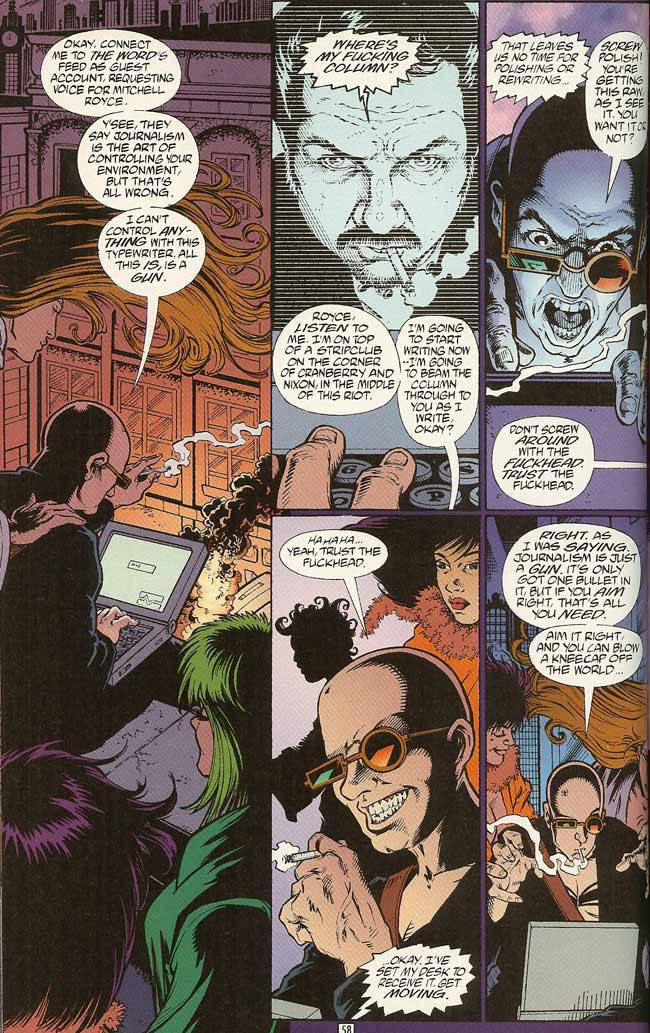
Overview: Ever since Blade Runner, the city has been the host for all that is seedy, slimy and scum ridden. But nobody does the cyberpunked city like Transmetropolitan, and nobody covers it like Spider Jerusalem. Jerusalem shows us the hyper-real – dregs of the dregs. Worse than you can imagine, the authorities shit all over the poor, downtrodden and destitute. And in this future, the poor aren’t just poor now, they’re transient, non-human, and sometimes shocked from being revived from a 200 year-old cryogenically frozen head and reinserted into a new body! Yes, this is the dystopian future, and up-close and nasty! No perversion is too big, and no secret is too nasty to uncover. Transmetropolitan was originally published as 60 different comic books, but is now only available in 10 Trade Paperbacks (TPBs), with one additional greatest hit TPB. You can get them on Amazon for around $10 bucks a piece, or sometimes may be able to get them cheaper from Ebay.
The Setting: In an unspecified distant dystopic future, America has become a place where there is the City, and then everything else. The City (no name is given or required) is a humongous massive sprawl, where every type of lowlife imaginable eaks out their miserable existence as best they can. Half the population in the city is doped up on all sorts of mild-altering, hallucinogenic drugs available. Body modifications are all the rage. Extra breasts, werewolf teeth, transplanting one’s mind into the body of a dog – nothing is too weird or forbidding. Many people called transients are slowly transforming themselves into aliens by injecting alien DNA to replace their own. Deviant religions abound – everything from religions celebrating pedophiles to continuous sex are intermixed with judgmental rants and insane prophecies. The rich and powerful live an idyllic existence in this new word order. Corporations and politicians both have the same goals – to fuck the population for their own benefits and gratification. Media feeds of all varieties abound in the Transmetropolitan future. The City is fully wired and monitored so that every happening can be recorded and played back for national amusement. Talk shows have even gotten more deviant than they already are today.
It is in this environment that Spider Jerusalem conducts his unique brand of journalism. While most of the newsmen of his time cower in the shadows and happily receive crap spewed from public liaison officers, Spider goes amongst the people to find the story. Early on, many of the mini-stories appear to be unrelated sub-plots, yet in the end, everything is connected.
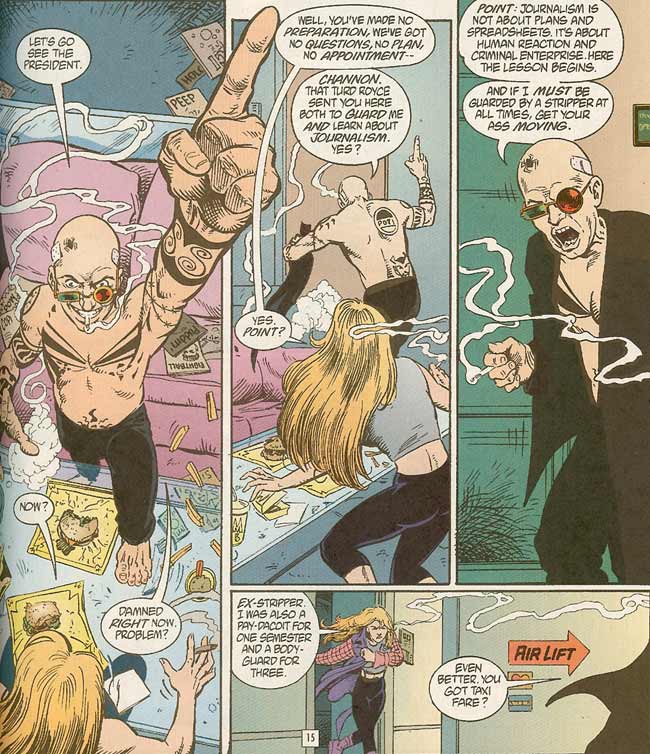
The Story: Infamous journalist, Spider Jerusalem, has been out of the game for five years, living in peace on his cabin in the mountains, when threats of lawsuits for unfinished work bring him back to the city. Spider has to write two books he’s already been paid for, but his money ran out long ago. To pay the bills, Spider gets a weekly column titled “I hate this city” at a daily newspaper called The Word, who pays his room and board. Spider starts covering the slime that is the city by all means available – news feeds, old contacts, and walking the worst neighborhoods to get up close and personal with the scum-ridden results of power gone awry. His columns bring down a corrupt president he calls the Beast, and then are targeted at torturing an even worse replacement Spider calls the Smiler. But more than that, they’re a vehicle for exploring this new, hyper-real society that Transmetropolitan brings us.
Spider Jerusalem: Spider Jerusalem is a Bastard. He chain smokes, pops every kind of drug he can find, masturbates constantly, pisses on anyone and anything, and has just about every kind of sickening human trait that humans can have. His weapon of choice is an illegal bowel disrupter, which causes people to immediately shit themselves into a stupor. Truly, Spider is the worst kind of bastard in that his pursuit of journalism is always the ultimate righteousness – the ultimate truth. No matter that thousands of people get wasted as a consequence of Jerusalem’s story.
The Truth Rules Everything: For Spider Jerusalem, the truth is all that matters. In Transmetropolitan, everyone and everything is a facade waiting to be uncovered. All politicians are not only crooked, they’re the worst that humanity has to offer. Everyone has an angle; a game they play that requires that they fuck up some poor underclass group in order to crawl to the top. And while exposing the truth is drives everything Jerusalem does, knowledge is transient. There are no truths of mankind in Transmetropolitan – the world as we know it has been deconstructed. All that’s left are the pieces.
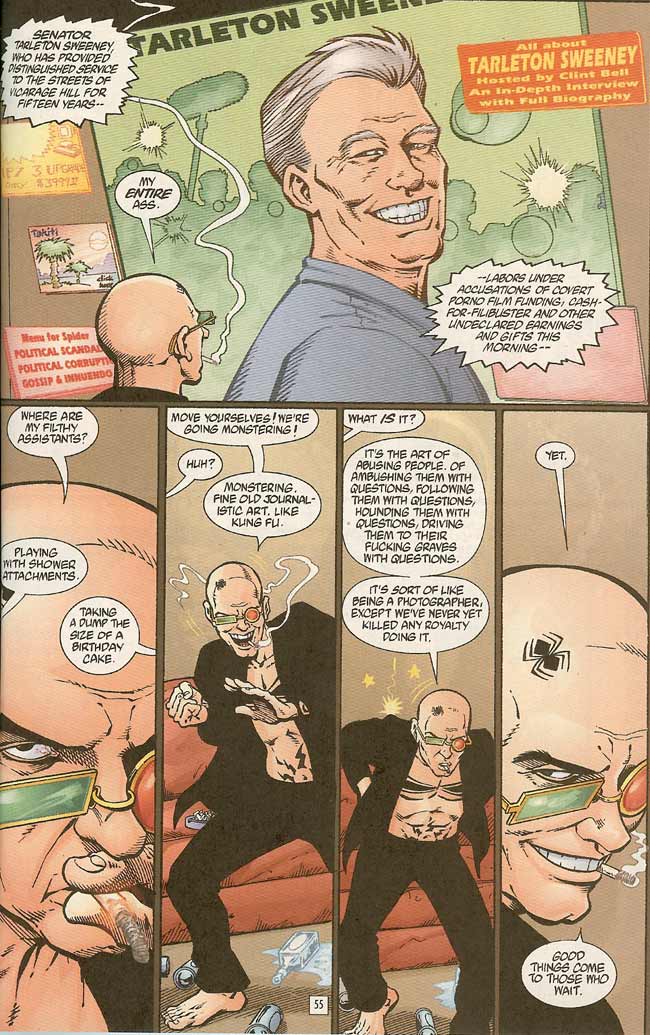
The Filthy Assistants: Spider has two assistants: Channon Yarrow and Yelena Rossini. Both of them develop a low-hate (mostly hate) relationship with Spider over the course of the series. Well, that’s not quite true – they start off hating him (REALLY hating him in Yelena’s case), and over time, they begin to understand him. Channon Yarrow eventually becomes his body guard while Yelena becomes his journalist assistant, but both evolve deliciously over the course of the series. Eventually, Spider, Yarrow and Yelena become an unstoppable trio.
The Writing & Artwork: Transmetropolitan is a terrific collaboration between two unassuming folks in the comic industry that succeeded in shooting for greatness. Warren Ellis, the writer of Transmetropolitan, does consistently brilliant work throughout the series. His dialogue is creative and always interesting (see the page scan above for an example). Spider Jerusalem clearly has a unique voice – one that creates mood all to its own. Additionally, the overall story arc is intricate, well written and wonderfully constructed. Flat out, Transmetropolitan provides us some of the best cyberpunk writing ever. Perfectly meshed with this story is Darick Robertson’s absolutely terrific down and dirty artwork. He seems to continually experiment in issue after issue - constantly trying new looks and different approaches while keeping the core intact. Far more often than not, this experimentation gives Transmetropolitan an almost constantly refreshed look.
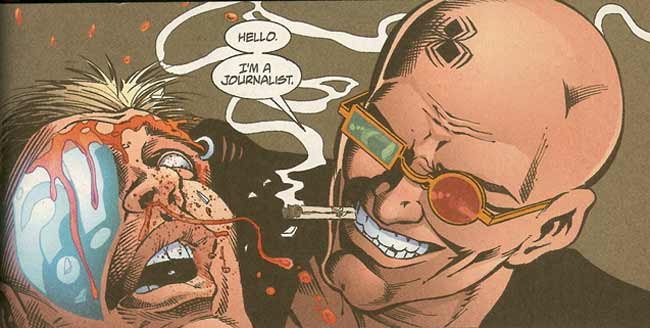
The Bottom Line: If you want to delve into one of the best graphic novels that cyberpunk has to offer, look no further than Transmetropolitan. The overall story is wonderfully constructed, and boasts extreme diversity in composition and approach while at the same time forming a coherent and satisfying whole. Once you start the first volume, you’ve have a hard time putting it down. By the time you read the second volume, you WILL be hooked for the rest of the series. As scary as these sounds, after reading just a few of their stories, you really will believe that the City is a real place. Sadly though, after you get familiar with Spider Jerusalem, you’ll notice yourself even more depressed than previously about the current state of our news media – they really don’t seem to be striving for the truth. In fact, they seem to be an integral part of the hypocritical bullshit that Spider is constantly exposing. If only Spider were real. 
Page 2: More Page Scans –>>
This post has been filed under Graphic Novels by SFAM.
|


















